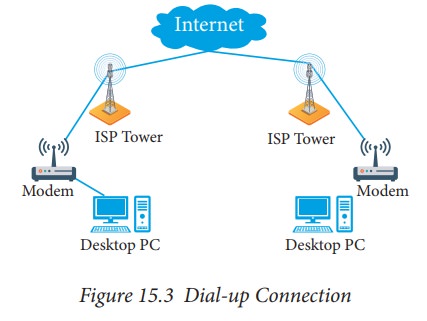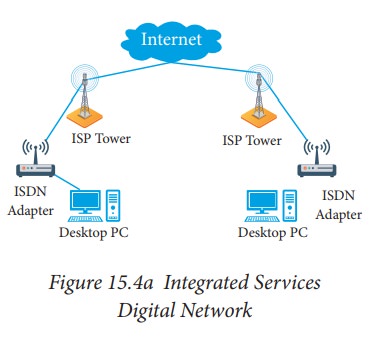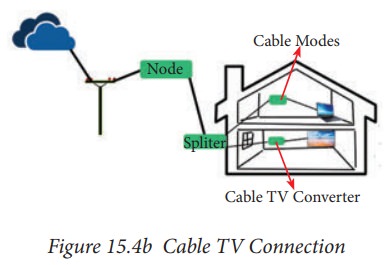Hardware to Connect and Desconnect Structures Easy
The following are the methods of connecting a computer to the Internet using software and hardware peripherals.
Hardware and Software Requirements for Internet connection: The following are the methods of connecting a computer to the Internet using software and hardware peripherals. • Connecting a computer using Wireless Broadband • Connecting a computer using an Ethernet Cable • Connecting a Computer Using Dial-Up Community • To connect the Internet, any one of the following is mandatory. • Modem is used to connect Internet thorugh Telephoneconnection. • NIC- Network Interface Card(wired/ wireless) facility is the most important hardware required to connect Internet. For example, the Laptop can be connected Internet through the wired/wireless. • Dongle is used to connect the Internet using cellular network • Wi-Fi router or Hotspot is used to connect the Internet using wireless network • Electronic device which supports cellular network • Internet Connectivity such as Dial-up connection, ISDN, DSL, Cable TV, wired and wireless (Cellular) Network. • The operating system should support TCP (Transfer Control Protocol) / IP (Internet Protocol), SMTP (Simple Mail Transfer Protocol), FTP (File Transfer Protocol), HTTP (Hyper Text Transfer Protocol) and HTTPS (Hyper Text Transfer Protocol Secured) protocols. • Browsers and other Internet clients access to the web applications such as Outlook, Gmail, Whatsapp, Facebook, Twitter and etc. The following methods are able to connect internet. A dial-up connection is established when two or more data communication devices use a Public Switched Telephone Network (PSTN) to connect to an Internet Service Provider (ISP) from computers. Many remote locations depend on Internet dial-up connections because broadband and cable are rare in remote areas with low population. Internet Service Providers often provide dial-up connections, a feasible alternative for budget-conscious subscribers. ISDN is the acronym of Integrated Services Digital Network. It establishes the connection using the phone lines (PSTN) which carry digital signals instead of analog signals. It is a set of communication standards for simultaneous digital transmission of data, voice, video, and other services over the traditional circuits of the public switched telephone network. There are two techniques to deliver ISDN services such as Basic Rate Interface (BRI) and Primary Rate Interface (PRI). The following diagram shows accessing internet using ISDN connection: Digital Subscriber Line (DSL) is a high-speed Internet service for homes and businesses that competes with cable and other forms of broadband Internet. DSL provides high-speed networking over ordinary Telephone lines using broadband modem technology. The technology behind DSL enables Internet and telephone service to work over the same phone line without requiring customers to disconnect either their Voice or Internet connections. The cable TV network can be used for connecting a computer or a local network to the Internet, competing directly with DSL (Digital Subscriber Line) technology. This type of network is classified as HFC (Hybrid Fiber-Coaxial), as it uses both fiber optics and coaxial cables. The connection between the cable TV company to the distribution points (Optical nodes) is made using fiber optics, with distances up to 25 miles (40 km). Each optical node is typically serves between 500 and 2,000 clients (customers). The following diagram shows that how internet is accessed using Cable TV connection: Satellite Internet access is Internet access provided through satellite communication for domestic and enterprise usage. The facility of modern consumer grade satellite Internet service is typically provided to individual users through geostationary satellites . It provides fairly high data speeds, along with latest satellites using Ka-band to attain downstream data speeds up to 50 Mbps internet speed. It is a technology for wireless local area networking with devices based on the IEEE 802.11 standards. Devices that can use Wi-Fi technology include personal computers, video-game consoles, phones and tablets, digital cameras, smart TVs, digital audio players and modern printers. Wi-Fi compatible devices can connect to the Internet via a WLAN and a wireless access point. Such an access point (or hotspot) has a range of about 20 meters (66 feet) indoors and a greater range of outdoors. Hotspot coverage can be as small as a single room with walls that block radio waves, or as large as many square kilometres achieved by using multiple overlapping access points. Three
Hardware Requirement :
Software Requirement
Connection Types:
Dial-up Connection :

ISDN

DSL:
Cable TV Internet Connection (setup box):

Satellite Internet Connection:
Wireless Internet Connection:
Study Material, Lecturing Notes, Assignment, Reference, Wiki description explanation, brief detail
11th Computer Technology : Chapter 15 : Internet and E-Mail : Hardware and Software Requirements for Internet connection |
Source: https://www.brainkart.com/article/Hardware-and-Software-Requirements-for-Internet-connection_36836/
0 Response to "Hardware to Connect and Desconnect Structures Easy"
Post a Comment